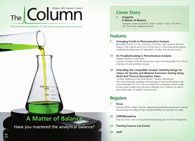Emerging Trends in Pharmaceutical Analysis
Benedetto Natalini of the University of Perugia, Italy, spoke to Bethany Degg of The Column about the driving forces in pharmaceutical analysis, including the importance of regulation, chirality, and miniaturization.
Benedetto Natalini of the University of Perugia, Italy, spoke to Bethany Degg of The Column about the driving forces in pharmaceutical analysis, including the importance of regulation, chirality, and miniaturization. Natalini also discussed his recent research in chiral chromatography, as well as developments in diagnostics using novel orthogonal liquid chromatography (LC) methods to quantify neurotransmitters involved in Parkinson's disease.
Q. Why is pharmaceutical analysis important and what areas are you focusing on at the moment?
A: Regulators worldwide require increasingly high quality and safety standards from the pharmaceutical industry. To ensure these standards are met, reliable analysis tools and methods are constantly required and developed by analytical scientists. Pharmaceutical analysis therefore plays a pivotal role in advancing the concepts and theories of analytical science, as well as providing important information on practical aspects of drug design, quality control, and quality assurance of industrial manufacturing. Chiral analysis also plays an important role in the pharmaceutical analysis.

Photo Credit: Image Source/Getty Images
The current trend in drug discovery towards enantiomerically pure drugs is the result of the need to reduce the dose of a drug, simplify the dose-response relationship, and reduce the toxicity caused by the therapeutically less active (or inactive) enantiomer.
There is, therefore, a great demand for chiral separations to determine enantiomeric purity at the early stages of the drug development process; for enantioselective bioanalysis in clinical trial studies; to analyze drugs in the environment; and for the quality control of medical products and their raw materials. All these areas have played a part in my research activities, which involves the study of the main principles governing the molecular recognition mechanism in the various domains of chiral chromatography.
Another area of my research is aimed at devising chromatographic strategies to determine the physico-chemical properties of pharmaceutically relevant compounds. I have also recently been involved in nutraceutical analytical chemistry in relation to the study of the enantiomeric composition of amino acids and other functional compounds in fresh and treated foodstuffs, as well as the development of new high performance liquid chromatography (HPLC) methods for bioanalytical studies.
Q. How has pharmaceutical analysis evolved and what are the most interesting recent trends?
A: Pharmaceutical analysis methods are traditionally and commonly applied to the chemical analysis of drug molecules. However, in the last two decades, modern pharmaceutical analysis has evolved enormously, capitalizing on combination techniques, high-throughput technologies, chemometrics, and most recently miniaturization and nanotechnology.
The combination of various techniques allows the modern pharmaceutical analyst to exploit the virtues of each technique and, in turn, to improve the overall quality of analysis. Indeed, modern analytical techniques and methods offer the possibility of increasing the amount of information received from individual analysis, with reduced cost, analysis time, and sample volumes.
High-throughput technologies are having an increasingly important role in early-stage drug development, providing a fast qualitative and quantitative characterization of thousands of compounds evaluated in the frame of preclinical and clinical ADME (Absorption, Distribution, Metabolism, Excretion) studies.
The principal component analysis (PCA) and projections to latent structures (PLS) are two chemometric methods applied in the domain of computer-aided drug discovery, and which prove particularly successful in early stage preclinical research as a fast computational and analytical tool for screening the increasing numbers of potential drug candidates.
The interest in miniaturization technology has grown rapidly, particularly in the pharmaceutical industry where it has been fuelled by the need to speed-up the analysis in high-throughput screening applications. Research in this area is particularly focused on "lab-on-a-chip" nanotechnology because of the potential to identify, study, and evaluate new drug entities. Nanotechnology will have an increasingly important role in the development of commercial analytical and preparative tools.
Q. Why is there so much emphasis on chiral analysis and the detection of enantiomers?
A: Confronted with the disastrous consequences of the "Thalidomide Drama", scientists in academia, pharmaceutical industry, and drug regulatory authorities started recognizing the crucial role of drug stereochemistry in the development of new pharmaceutically active ingredients. In response to the enhanced knowledge on enantioselective drug action, in the early 1990s a pragmatic approach to the regulation of chiral drugs was imposed.
In most countries, regulatory authorities require separate (or distinct) pharmacological and toxicological tests of the racemate and the individual enantiomers. This means that both racemate and enantiomers must be tested separately. The decision to develop the racemate or single isomer is then mainly based on (a) achievement and exhibition of safety and efficacy of the new drug and (b) optimal use of time and money: In this frame, the development of the racemate is sometimes the appropriate decision, with a number of issues favouring the development of the only enantiomer endowed with activity.
The recognition of chirality as a new asset in drug development has had an enormous effect on the product pipelines of the major players in the pharmaceutical industry, unavoidably leading to the development of numerous enantiorecognition systems, mostly in the various domains of chromatography, as well as of increasingly improved methods of analysis.
Enantiomers of specific compounds have been established to act as neuromodulators or neurotransmitters in the central nervous system, while others were found to play an important role in endocrine tissues. Interestingly, the occurrence of racemization of certain compounds in biological fluids and tissues can be associated to various pathophysiological conditions. All these relatively new acquisitions have expanded the interest towards chirality issues as a whole.
Q. In a recent study by your research group, novel orthogonal liquid chromatography methods were applied to quantify neurotransmitters involved in Parkinson's disease.1 What were the main objectives of this study?
A: Parkinson's disease is a multifactorial neurodegenerative disorder, characterized by severe motor and non-motor symptoms resulting from a selective loss of the dopaminergic neurons in the nigrostriatal pathway, with consequent reduction of dopamine (DA) levels. A relatively long preclinical phase precedes classical motor symptoms that appear when more than 80% of dopaminergic neurons are lost. Indeed, non-motor symptoms, primarily cognitive dysfunction, often occur many years before the appearance of movement disorders, thus limiting a prompt medical diagnosis. Moreover, the molecular pathways involved in the pathogenesis of disease have not yet been fully disclosed. In this scenario, we were motivated to develop new diagnostic tools to evaluate early stage depletion of DA and of some of its metabolites (3,4-dihydroxyphenylacetic acid, DOPAC; homovanillic acid, HVA; 3-methoxytyramine, 3-MT), thus facilitating biochemical evaluations and clinical applications at once.
A recent study showed that the neurons responsible for DA release also produce the neurotransmitter gamma-aminobutyric acid (GABA), which, in contrast to DA, contributes to limit the neuronal hyperactivity. Accordingly, we deemed it interesting to develop an HPLC method for the quantitative measurements of GABA levels in specific biological samples, to apply for diagnostic purposes.
The information derived from the chromatographic study, when combined to those from imaging approaches, could facilitate the diagnosis at different stages.
Q. Why did you choose reversed-phase ion-pairing chromatography (IPC) and hydrophilic liquid interaction chromatography (HILIC) for this study?
A: To take advantage of MS-compatible chromatographic methods providing distinct selectivity profiles, which enhances the chance of correct species quantification, and allows the compensation of the intrinsic limits characterizing all (single dimension) chromatographic methods. To the best of my knowledge, this represents the first study in which the above fairly orthogonal methods have been complementarily and successfully applied to real samples with this aim.
Q. What were your main findings? What are the advantages of your novel approach compared to existing methods? Are other applications possible?
A: The two fairly orthogonal HPLC methods were directly applied to the biological samples without preliminary derivatization of the compounds of interest. A high level of selectivity was obtained for dopamine metabolites and GABA by running the gradient reversed-phase IPC method with a volatile ion-pairing reagent, which makes it suitable for the quantitative assay of four out of five compounds. Matrix-deriving interferences enabled the baseline separation of dopamine, which was instead successfully achieved with the HILIC-based method.
As previously reported, taking advantage of HPLC methods providing distinct selectivity profiles makes correct species quantification possible and allows analysts to compensate the intrinsic limits characterizing all chromatographic methods. The two HPLC methods offer a valid contribution to neuroscience research and are potentially applicable to several human biological samples. This approach will make it possible to diagnose the early-stage of pathologies or to monitor the progression of some neurodegenerative disorders characterized by depletion of vital neurotransmitters.
Q. Where do you see your research taking you in the future? Do you have anything further to add?
A: My future research activity will focus on (a) studying the variation of the enantiomeric composition of chiral biomarkers in biological samples from healthy to pathological conditions with 2D HPLC applications; (b) developing new HPLC methods to identify and quantify chiral biomarkers of bacterial contamination in foodstuffs; and (c) gaining a deeper understanding into the basic principles governing the enantiorecognition mechanism with both low- and high-molecular-weight chiral selectors used in LC applications, through the development and application of spectroscopic and molecular dynamic-based computational protocols.
Reference
1. R. Sardella, S. Scorzoni, C. Conte, A. Lisanti, F. Ianni, and B. Natalini, Journal of Pharmaceutical and Biomedical Analysis98, 253–259 (2014).
Benedetto Natalini graduated in chemistry at the Institute of Organic Chemistry, Faculty of Science, University of Perugia (Italy) in 1973. After military service, he began his research activity in 1976 at the Institute of Medicinal Chemistry and Pharmaceutical Technology, Faculty of Pharmacy, University of Perugia (Italy). In 2003 he was designated an expert for the ECM National Programme by the Ministry of Health. In 2010 he was an Editor of the International Journal of Medicinal Chemistry. In 2011 he became coordinator of the International Doctorate in Chemistry and Technology of Drugs. From November 2011 to December 2013 he was Director of the Department of Chemistry and Technology of Drugs at the University of Perugia (Italy). Since January 2014 he has been Director of the Department of Pharmaceutical Sciences at the University of Perugia.
E-mail: benedetto.natalini@unipg.it
Website: http://www.unipg.it/it/pagina-personale?matricola=000818
This article is from LCGC's digital magazine, The Column. Click here to view the issue.

Common Challenges in Nitrosamine Analysis: An LCGC International Peer Exchange
April 15th 2025A recent roundtable discussion featuring Aloka Srinivasan of Raaha, Mayank Bhanti of the United States Pharmacopeia (USP), and Amber Burch of Purisys discussed the challenges surrounding nitrosamine analysis in pharmaceuticals.
Silvia Radenkovic on Building Connections in the Scientific Community
April 11th 2025In the second part of our conversation with Silvia Radenkovic, she shares insights into her involvement in scientific organizations and offers advice for young scientists looking to engage more in scientific organizations.
Regulatory Deadlines and Supply Chain Challenges Take Center Stage in Nitrosamine Discussion
April 10th 2025During an LCGC International peer exchange, Aloka Srinivasan, Mayank Bhanti, and Amber Burch discussed the regulatory deadlines and supply chain challenges that come with nitrosamine analysis.










